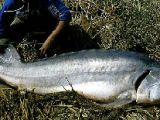When a fish is known for its eggs rather than for the way it looks, this is a bad sign. There are 23 species of sturgeon fishes, assigned to 4 genera, all living in Northern Hemisphere, but if the name sturgeon sounds strange for many, caviar is linked by anybody to opulence. And this has been so since the ancient Phoenicians and Romans.
Many are willing to pay astronomic prices for a little caviar, but very few know how a sturgeon looks like. These fishes are extremely old, appearing during the dinosaur era, and are somewhat intermediary between sharks and bony fish.
Like sharks, they have a cartilage-made skeleton, similar fins and a snout, but like the bony fish, their gills are covered by a bony operculum. They have no teeth and feed on invertebrates and small fish.
The sturgeons live on the temperate coasts of Europe, North America and Eastern Asia, but the highest diversity is found in the basins of the Black and Caspian Seas (4 endemic species); 3 small endemic species are endemic in the Aral Sea basin.
Except just one species, the sterlet (Acipenser ruthenus), which lives only in rivers, all the other species of sturgeons have a lifestyle similar to the salmon: the adults feed in the sea and when they are 10 years old start spawning migrations in large rivers, up to their middle sector.
The sticky eggs from the caviar are to be found among the rocks on the bottom of the rivers till they hatch. 15 kg of caviar means 1,300,000 eggs. Unfortunately, very few young survive. After one year on the river, the young go to the river's mouth, getting accustomed to the salty waters.
But unlike the salmon, the adults do not die after spawning, returning to the sea and spawning many times during their long lifespan, some over one century and most species at least 40 years.
Due to their reproductive style, sturgeon species are severely affected by the buildings of dams and rivers' contamination. By over 40 years, no sturgeon can advance on Danube upper than Romania, due to the Iron Gate Dam.
Sturgeons experience uncontrolled exploitation worldwide and most species have reached critical situations: the Atlantic sturgeon now reproduce only in the Gironde-Garonne-Dordogne basin in France and in the Rioni basin in Georgia. In 1992, the last individual was captured in Guadalquivir (Spain).
Even if occasional individuals are caught in some rivers, they do not represent viable populations.
Like in all fishes, the amount of caviar (eggs) is linked to the female's size: a female with a length of 1.8 m (6 ft) and weighing 90 kg (200 pounds) can deliver 5 to 15 kg (12 to 40 pounds) of caviar. A beluga (the largest sturgeon, inhabiting the Black and Caspian seas basins) female delivered 120 kg (270 pounds) of caviar. She was 4.2 m (14 ft) long and weighed 996 kg (2,400 pounds). Belugas can double this weight and reach 6 m (20 ft) in length.
The beluga's caviar is the most expensive in the world and this can be considered the most expensive fish in the world. The sturgeon meat, usually smoked, (and called "batog" in the Danube area), is also priced in some countries. The beluga is also the largest fish entering rivers.
The best caviar is that coming from the sturgeons of the Black and Caspian Seas. In fact, during 1932 - 1970, when Spanish caught 600 individuals annually in Guadalquivir, the Spanish cans with local caviar were labeled with Cyrillic letters!
90 % of the world's caviar comes from two rivers flowing into the Caspian: Volga and Ural. But the high price of the caviar (4.808 Euro or $ 6,561 per kilogram) has been fueling an intensive illegal fishing of the sturgeons.
This was helped also by the disorder reigning in the countries of the ex-USSR bordering the Caspian Sea: Russia, Kazakhstan, Azerbaijan and Turkmenistan, making the illegal captures ten times higher than the legal ones. Iran remains the only country in the area respecting the assigned quotas.
All these factors plummeted the sturgeons' population in the area. Russia captured 25,100 tonnes of sturgeons in 1980 but only 500 in 2001.
CITES menaced with paralyzing the caviar trade several times, but the fight is extremely hard, as criminal organizations, similar to those controlling drug trafficking, have arisen around the illegal fishing of the sturgeons. The poachers have better boats and weapons than the guards.

 14 DAY TRIAL //
14 DAY TRIAL // 
